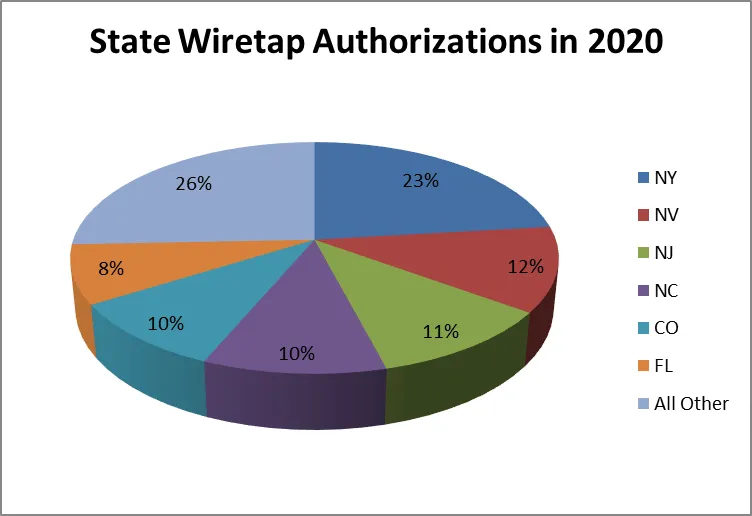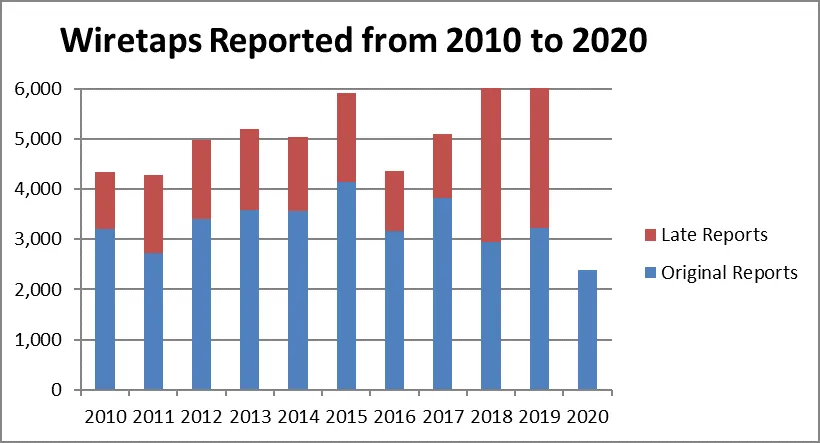This report covers wiretaps concluded between January 1, 2020, and December 31, 2020, as reported to the Administrative Office of the U.S. Courts (AO), and provides supplementary information reported to the AO on arrests and convictions resulting from wiretaps concluded in prior years.
Forty-eight jurisdictions (the federal government, the District of Columbia, the Virgin Islands, Puerto Rico, and 44 states) currently have laws that authorize courts to issue orders permitting wire, oral, or electronic surveillance. Table 1 shows that a total of 18 jurisdictions (including state and federal entities) reported using at least one of these types of surveillance as an investigative tool during 2020.
Summary and Analysis of Reports by Judges
The number of federal and state wiretaps reported in 2020 decreased 26 percent from 2019. A total of 2,377 wiretaps were reported as authorized in 2020, with 1,297 authorized by federal judges and 1,080 authorized by state judges. Compared to the applications approved during 2019, the number approved by federal judges decreased 8 percent in 2020, and the number approved by state judges decreased 40 percent. The reduction in approved applications has been attributed mainly to the effects of the COVID-19 pandemic.
In 17 states, a total of 105 separate local jurisdictions (including counties, cities, and judicial districts) reported wiretap applications for 2020. Applications concentrated in six states (New York, Nevada, New Jersey, North Carolina, Colorado, and Florida) accounted for 74 percent of all state wiretap applications.

Eighty-three federal jurisdictions submitted reports of wiretap applications for 2020. The Southern District of New York authorized the most federal wiretaps, approximately 5 percent of the applications approved by federal judges.
Federal judges and state judges reported the authorization of 476 wiretaps and 125 wiretaps, respectively, for which the AO received no corresponding data from prosecuting officials. Wiretap Tables A-1 and B-1 (which are available online at http://www.uscourts.gov/statistics-reports/analysis-reports/wiretap-reports) contain information from judge and prosecutor reports submitted for 2020. The entry “NP” (no prosecutor’s report) appears in these tables whenever a prosecutor’s report was not submitted. Some prosecutors may have delayed filing reports to avoid jeopardizing ongoing investigations. Some of the prosecutors’ reports require additional information to comply with reporting requirements or were received too late to include in this document. Information about these wiretaps should appear in future reports.
Wiretap Orders, Extensions, and Locations
Table 2 presents the number of wiretap orders issued in each jurisdiction that provided reports, the number of extensions granted, the average lengths of the original periods authorized and any extensions, the total number of days in operation, and the locations of the communications intercepted. Federal and state laws limit the period of surveillance under an original order to 30 days. This period, however, can be lengthened by one or more extensions if the authorizing judge determines that additional time is justified.
During 2020, the average reported length of an original authorization was 30 days, the same as in 2019. The average reported length of an extension was also 30 days. In total, 1,503 extensions were reported as requested and authorized in 2020, a decrease of 41 percent from the prior year. The District of Arizona (AZ) conducted the longest federal wiretap that was terminated in 2020. One original order in AZ was extended 8 times to complete a 257-day wiretap used in an immigration investigation. An order in the Central District of California was extended 7 times to complete a 240-day wiretap in a narcotics investigation. For state intercepts terminated in 2020, the longest wiretap occurred in Onondaga, New York, where an original order was extended 19 times to complete a 552-day wiretap used in a narcotics investigation.
The most frequently noted location in reported wiretap applications was “portable device.” This category includes cell phone communications, text messages, and application software (apps). In 2020, a total of 95 percent of all authorized wiretaps (2,270 wiretaps) were reported to have used portable devices.
Prosecutors, under certain conditions, including a showing of probable cause to believe that actions taken by a party being investigated could have the effect of thwarting interception from a specified facility, may use “roving” wiretaps to target specific persons by using electronic devices at multiple locations rather than at a specific telephone or location (see 18 U.S.C. § 2518(11)). In 2020, a total of 14 reported federal and state wiretaps were designated as roving.
Criminal Offenses
Drug offenses were the most prevalent type of criminal offenses investigated using reported wiretaps. Table 3 indicates that 39 percent of all applications for wiretaps (922 wiretap applications) in 2020 cited narcotics as the most serious offense under investigation. Applications citing narcotics combined with applications citing other offenses, which include other offenses related to drugs, accounted for 77 percent of all reported wiretap applications in 2020, an increase of 1 percent from 2019. Conspiracy, the second-most frequently cited crime, was specified in 13 percent of applications. Racketeering, the third-largest category, was specified as the most serious offense in approximately 5 percent of applications. Many applications for court orders revealed that multiple criminal offenses were under investigation, but Table 3 includes only the most serious criminal offense listed on an application.
Lengths and Numbers of Wiretaps
In 2020, reported installed wiretaps were in operation for an average of 42 days, 12 days shorter than the average in 2019. The federal wiretap with the most intercepts occurred during a murder investigation in the Eastern District of California (CA-E) and resulted in the interception of 327,492 messages in 60 days. The state wiretap with the most intercepts was a 552-day wiretap for a narcotics investigation in Onondaga, New York, which resulted in the interception of 429,356 cell phone conversations and messages. See Table A-1 and Table B-1 for data on lengths and numbers of intercepts.
Encryption
The number of state wiretaps reported in which encryption was encountered decreased from 343 in 2019 to 184 in 2020. In 183 of these wiretaps, officials were unable to decipher the plain text of the messages. A total of 214 federal wiretaps were reported as being encrypted in 2020, of which 200 could not be decrypted.
Cost of Wiretaps
Table 5 provides a summary of expenses related to wiretaps in 2020. The expenditures noted reflect the cost of installing wiretap devices and monitoring communications for the 1,083 authorizations for which reports included cost data. The average cost of a wiretap in 2020 was $119,418, up 59 percent from the average cost in 2019. The most expensive state wiretap that resulted in reported arrests was in New York, where costs for an 83-day wiretap conducted to investigate a narcotics offense resulted in 20 arrests and totaled $1,383,476. For federal wiretaps for which expenses were reported in 2020, the average cost was $101,046, a 7 percent increase from 2019. The most expensive federal wiretap completed during 2020 that resulted in reported arrests occurred in the Western District of Pennsylvania, where costs for a 180-day wiretap in a narcotics investigation resulted in 21 arrests and totaled $1,628,292.
Methods of Surveillance
The three major categories of surveillance are wire, oral, and electronic communications. Table 6 presents the type of surveillance method used for each wiretap installed. The most common method reported was combination surveillance, which refers to installed intercepts for which more than one type of surveillance was used. Combination surveillance accounted for 53 percent (940 cases) of the intercepts installed in 2020, the majority of them involving cellular telephones.
Arrests and Convictions
Data on individuals arrested and convicted as a result of wiretaps reported as terminated are presented in Table 6. As of December 31, 2020, a total of 6,574 persons had been arrested (down 38 percent from 2019), and 311 persons had been convicted (down 88 percent from 2019). Federal wiretaps were responsible for 45 percent of the arrests and 33 percent of the convictions arising from wiretaps for this period. The Eastern District of California reported the most arrests for a federal district in 2020, with wiretaps there resulting in the arrest of 342 individuals. New Jersey reported the most convictions for a federal district in 2020, with wiretaps there resulting in the conviction of 28 individuals. State wiretaps were responsible for 55 percent of the arrests and 67 percent of the convictions arising from wiretaps for this period. The NYC Special Narcotics Bureau reported the largest number of arrests (626). Pennsylvania reported the highest number of convictions (72) arising from a state wiretap in 2020.
Summary of Reports for Years Ending December 31, 2010, through December 31, 2020
Table 7 presents data on wiretaps requested and authorized each year from 2010 to 2020. Total authorized intercept applications reported by year decreased 45 percent from 4,336 in 2010 to 2,377 in 2020. Most wiretaps have consistently been used for narcotics investigations, which accounted for 84 percent of intercepts authorized in 2010 (2,675 applications) and 39 percent in 2020 (922) applications. Table 9 presents the total number of arrests and convictions resulting from intercepts terminated in calendar years 2010 through 2020.

Supplementary Reports
Under 18 U.S.C. § 2519(2), prosecuting officials must file supplementary reports on additional court or police activity occurring as a result of wiretaps reported in prior years. Because many wiretap orders are related to large-scale criminal investigations that cross county and state boundaries, supplemental reports are necessary to fulfill reporting requirements. Arrests, trials, and convictions resulting from these interceptions often do not occur within the same year in which the intercepts are first reported. Table 8 shows that 2,930 arrests, 581 convictions, and additional costs of $58,785,810 arose from and were reported for wiretaps completed in previous years. Seventy-seven percent of the supplemental reports of additional activity in 2020 involved wiretaps terminated in 2019. Wiretaps concluded in 2019 led to 72 percent of arrests, 65 percent of convictions, and 84 percent of expenditures noted in the supplementary reports.
